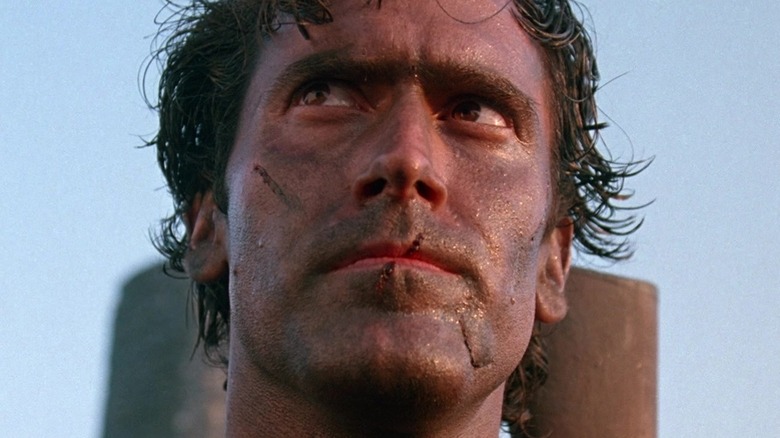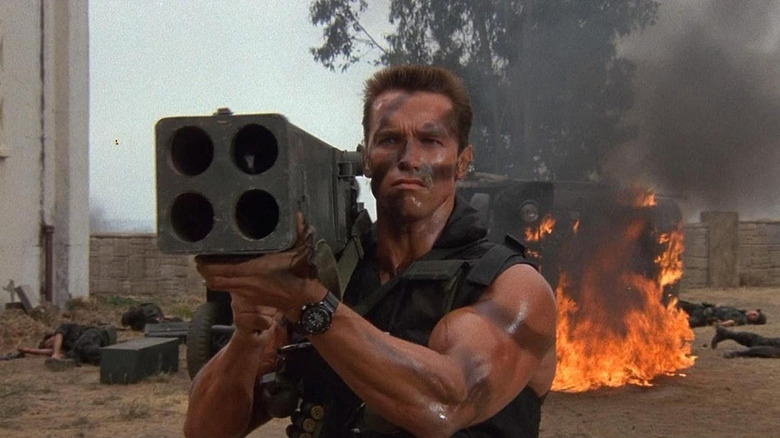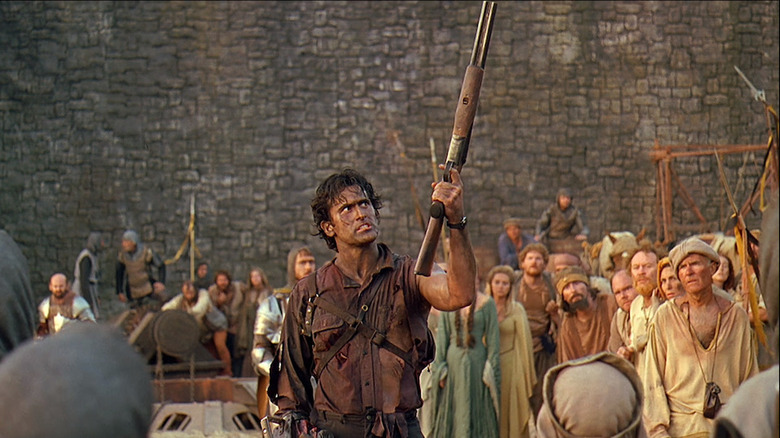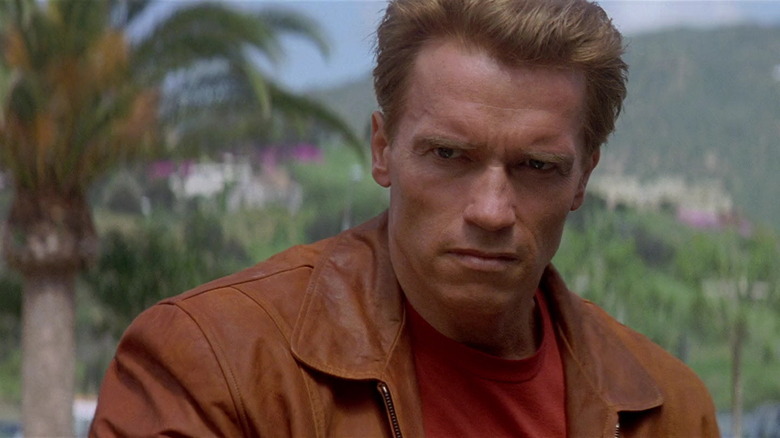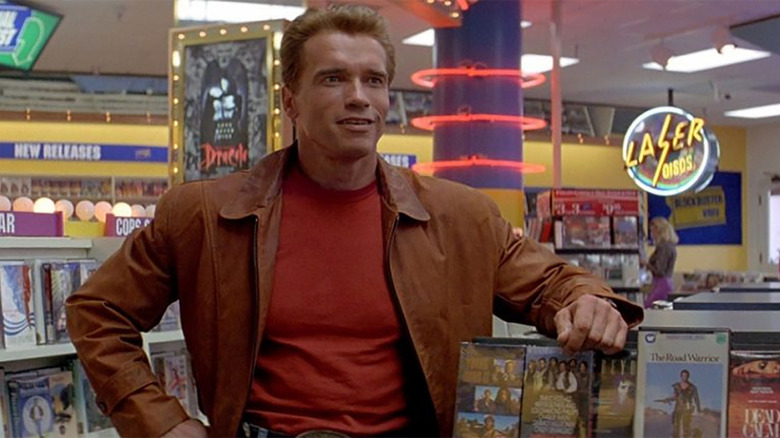Army Of Darkness And Last Action Hero Put The '80s Action Hero To Rest
It's a natural occurrence in art that trends, fads, subgenres, and the like must run their course. That doesn't necessarily mean they go away forever, just that their heyday is contained to a finite period of time.
Some trends are so of a moment, however, that even if their genre never goes away, the aesthetics particular to their peak can't come back completely. That's especially true of the 1980s action hero, a figure that only could have emerged during that decade of excess and one that had to say farewell once the more introspective 1990s rolled around.
As with most trends, it's debatable where to objectively define their start — and endpoints. A usually reliable bellwether is when a trend or genre is parodied or satirized. If the parody is external, it may signal the end (as 1980's "Airplane!" did regarding the disaster movie) or simply the genre's popularity (as with 2001's "Not Another Teen Movie").
If the satire comes from within the genre itself, however, it likely means that the trend has run its course. For the '80s action hero, two movies released in 1993 put a metaphorical lid on the larger-than-life, one-liner spouting macho man: "Army of Darkness" and "Last Action Hero."
The birth of the '80s action hero
While action movies in general have been and will always be a perennial part of the cinematic landscape, the specific offshoot that occurred during the 1980s was a result of numerous changing trends and factors in popular culture. The action hero had already been through a number of variations over the decades since movies began, ranging from square-jawed, morally upright authority figures to mythical portrayals of historical icons like the gladiator and the cowboy.
During the 1970s, thanks in part to increasing permissiveness in film, action heroes of all types tended to get darker, compromising their ethics in the name of justice and crossing numerous moral lines. These characters putting themselves above the law meant that, by the dawn of the '80s, it became de rigueur for action heroes to eschew all manner of ethical, legal, and moral boundaries. Audiences accepted their actions in a "might makes right" fashion, which — along with the unabashed freedom they enjoyed — made them fun to watch.
Even though superhero cinema would not become the norm until the 21st century, the characters portrayed by the likes of Arnold Schwarzenegger, Sylvester Stallone, Chuck Norris, Mel Gibson and others acted as de facto superheroes, larger-than-life characters who were ostensibly human but could miraculously survive any explosion if the script called for it. Their attitudes followed suit, as they displayed a confidence bordering on arrogance that was topped off with a sardonic wit, usually demonstrated in the form of a pithy one-liner uttered upon killing a baddie or blowing up a truck.
Although the '80s action hero type was changing by the end of the decade — John McClane in "Die Hard" was lauded for being visibly injured and exhausted during the film, for instance — the trend continued through the early '90s.
Army of Darkness: Bursting the action hero's balloon
Released in February of 1993, "Army of Darkness" was the unlikely follow-up to director Sam Raimi's "Evil Dead II." The movie steered the trilogy away from ultra-gory horror and toward throwback genre thrills á la Ray Harryhausen creature features and the swashbuckling adventures found in Medieval and pirate movie varieties.
Although "Army of Darkness" is much more of an adventure/horror hybrid than an action movie, the protagonist, Ashley J. Williams (Bruce Campbell), is a deliberate riff on the '80s action hero archetype. The character's action heritage began toward the end of "Evil Dead II," as the victimized and cowardly Ash transformed into a shotgun-toting, chainsaw-wielding prophesied savior by the film's end, quippy one-liners and all. "Army of Darkness" continues the character from this point, having him sarcastically put down just about everyone he encounters as he saunters about, showing off his weaponry and rippling musculature.
However, it's apparent that Raimi and Campbell are parodying the archetype as well as indulging in it. Ash is revealed to be a blowhard who screws up a little more than he helps, unleashing the army of the dead and eventually returning to his own time while unintentionally bringing the Evil with him. Instead of an idealized macho man like John Rambo or John Matrix, Ash's action-hero attitude is portrayed as a disreputable façade, an attitude he must earn as opposed to take for granted. As Ash battles and defeats an evil clone of himself (who demonstrates just as much if not more undue arrogance), he learns that doing the right thing (eventually) is more important than boasting about it.
Last Action Hero: The action hero wants to grow up
"Last Action Hero," as the title suggests, began as a direct parody of action films, with writers Zak Penn and Adam Leff riffing on Shane Black's distinctive hard-boiled style. However, Black (along with David Arnott) was eventually hired to re-write the script, turning the film into a more earnest summer blockbuster version of what was once parody. Director John McTiernan, who helped establish the '80s hero archetype with "Predator" and "Die Hard," saw an opportunity to send himself up while making another hoped-for smash with star Arnold Schwarzenegger. With the making of "Last Action Hero," one gets the distinct sense that contradiction (if not hypocrisy) was the order of the day — this is, after all, a movie featuring jokes about excessive and superfluous explosions that was promoted on a real-life rocket to space.
Even though "Last Action Hero" indulges in the very elements it seeks to satirize, it cleverly points out how the larger-than-life, constantly quipping '80s hero is beginning to stretch credulity. During the film, the fictional Jack Slater (Schwarzenegger) is befriended by a fan in the real world, Danny (Austin O'Brien), and is more hurt than flattered that Danny can predict his every move and reaction. Even though the film advocates for such characters providing escapist hope to a bleak reality, Slater's trip to the real world — including an encounter with a fictionalized, egotistical version of Schwarzenegger himself — causes him to want to be a more well-rounded man.
As such, when Slater eventually returns to the world on the other side of the movie screen, he's the one demanding that things be more realistic: "I don't want to shoot people anymore and blow up buildings," he demands, a sentiment that's as significant for the action hero as it is for the actor playing him.
The '80s action hero is dead, long live the action hero
Naturally, neither "Army of Darkness" nor "Last Action Hero" marked the exact end for the '80s action hero type, as new stars such as Jean-Claude Van Damme and Steven Seagal and veterans like Schwarzenegger and Stallone continued to make excessive action films well into the '90s. Yet things looked different in the action movie world during and after 1993: Stallone also sent up his screen persona with "Demolition Man," and former he-men like Kurt Russell started making more grounded fare like "Breakdown." Action films themselves became more concerned with the concept (as in "Speed" or "The Matrix") than as just potential vehicles for action stars.
As such, "Army of Darkness" and "Last Action Hero" act as a last hurrah, satirizing the '80s action hero at its peak before things were to inevitably shift and move forward. While both movies critique the archetype, they do so lovingly, allowing them to double as great examples of the trend while putting it to rest.
